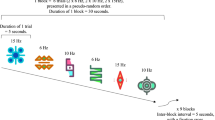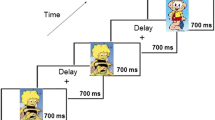Abstract
This study compared the visual ERPs and concurrently measured fixation times of autistic children with those of normal children and two psychiatric control groups (socalled “externalizers” and “internalizers”). Autistic children had, in contrast with normal control groups, smaller P3 waves (occipital maximum) to visual target stimuli but did not differ in this respect from the two psychiatric control groups. When the autistic group was split into “good” and “bad” performers, the latter group had significantly smaller amplitudes than the former. No difference was found between the groups in electrophysiological reactivity to the first, novel stimulus of a habituation series. However, an unexpected change in stimulus location induced an increased Fz N400 in the normal group but not in the autistic group or the two psychiatric control groups. In addition, in a non-task-relevant habituation condition, the autistic group fixated complex visual stimuli for shorter times and had smaller occipital P3 waves than the control groups. Analysis of covariance showed that the smaller P3s could not be explained by the shorter fixation times. In none of the ERP parameters were there differences in habituation rate between the controls and the autistic children.
Similar content being viewed by others
References
American Psychiatric Association. (1980).Diagnostic and statistical manual of mental disorders (3rd ed.). Washington, DC: Author.
Attneave, F. (1954). Some informational aspects of visual perception.Psychological Review, 61, 83–193.
Courchesne, E., Kilman, B., Galambos, R., & Lincoln, A. (1984). Autism: Processing of novel auditory information assessed by event-related brain potentials.Electroencephalography and Clinical Neurophysiology, 59, 238–248.
Courchesne, E., Lincoln, A. L., Kilman, B. A., & Galambos, R. (1985). Event-related brain potential correlates of the processing of novel visual and auditory information in autism.Journal of Autism and Developmental Disorders, 15, 55–76.
Courchesne, E., Lincoln, A. J., Yeung-Courchesne, R., Elmasian, R., & Grillon, C. (1989). Pathophysiologic findings in nonretarded autism and receptive developmental language disorder.Journal of Autism and Developmental Disorders, 19, 1–17.
Creak, E. M. (1961). Schizophrenia syndrome in childhood: Progress report of a working party.Cerebral Palsy Bulletin, 3, 501–504.
Draper, N. R., & Smith, H. (1981).Applied regression analysis. New York: Wiley.
Finn, J. D. (1978).Multivariance, version VI, release 2, Fortran IV program. Chicago: National Educational Resources.
Freund, R. J., & Minton, P. D. (1979).Regression methods—A tool for data analysis. New York: Marcel Dekker.
Gasser, T., Sroka, L., & Mocks, J. (1986). The correction of EOG artifacts by frequency dependent and frequency independent methods. Psychophysiology, 23, 704–712.
Gratton, G., Coles, M. G. H., & Donchin, E. (1983). A new method for off-line removal of ocular artifacts.Electroencephalography and Clinical Neurophysiology, 55, 468–484.
Harter, M. R., & Aine, C. J. (1984). Brain mechanisms of visual selective attention. In R. Parasuraman & E. R. Davies (Eds.),Varieties of attention. Orlando, FL: Academic Press.
Hermelin, B., & O'Connor, N. (1968).Psychological experiments with autistic children. Oxford: Pergamon.
Johnson, R. Jr., & Donchin, E. (1985). Second thoughts: Multiple P300s elicited by a single stimulus.Psychophysiology, 22, 182–194.
Laffont, F., Lelord, G., & Goldstein, J. (1979). Event-related potentials during sensory condition in autistic and in mentally retarded children. In J. E. Desmedt (Ed.), Cognitive components in cerebral event-related potentials and selective attention.Progress in Clinical Neurophysiology, 6, 280–288.
Leeuwenberg, E. L. (1967).Structural information of visual patterns. The Hague, The Netherlands: Mouton.
Lelord, G., Laffont, F., Jusseaume, P., & Stephant, J. L. (1973). Comparative study of conditioning of averaged evoked responses by coupling sound and light in normal and autistic children.Psychophysiology, 10, 415–425.
Martineau, J., Laffont, F., Bruneau, N., Roux, S., & Lelord, G. (1980). Event-related potentials evoked by sensory stimulation in normal, mentally retarded and autistic children.Electroencephalography and Clinical Neurophysiology, 48, 140–153.
Novick, B., Kurtzberg, D., & Vaughan, H. G., Jr. (1979). An electrophysiological indication of defective information storage in childhood autism.Psychiatry Research, 1, 101–108.
Novick, B., Vaughan, H. G., Jr., Kurtzberg, D., & Simson, R. (1980). An electrophysiological indication of auditory processing defects in autism.Psychiatry Research, 3, 107–114.
Ornitz, E. M. (1985). Neurophysiology of infantile autism.Journal of the American Academy of Child Psychiatry, 24, 251–262.
Prior, M. R. (1987). Biological and neuropsychological approaches to childhood autism.British Journal of Psychiatry, 150, 8–17.
Pritchard, W. S., Raz, N., & August, G. J. (1987). Visual augmenting/reducing and P300 in autistic children.Journal of Autism and Developmental Disorders, 17, 231–242.
Ritter, W., Vaughan, H. G., Jr., & Costa, L. D. (1968). Orienting and habituation to auditory stimuli: A study of short term changes in averaged evoked responses.Electroencephalography and Clinical Neurophysiology, 25, 550–556.
Rutter, M., & Schopler, E. (1978).Autism: A reappraisal of concepts and treatment. New York: Plenum Press.
Sokolov, E. N. (1963).Perception and the conditioned reflex. Oxford: Pergamon.
Stevens, S., & Gruzelier, J. (1984). Electrodermal activity to auditory stimuli in autistic, retarded, and normal children.Journal of Autism and Developmental Disorders, 14, 245–260.
Verbaten, M. N. (1983). The influence of information on habituation of cortical, autonomic and behavioral components of the orienting reaction. In A. W. K. Gaillard, & W. Ritter (Eds.),Tutorials in event related potential research: Endogenous components. Amsterdam: North-Holland.
Verbaten, M. N., Roelofs, J. W., Sjouw, W., & Slangen, J. L. (1986). Different effects of uncertainty and complexity on single trial visual ERPs and the SCR-OR in non-signal conditions.Psychophysiology, 23, 254–262.
Woestenburg, J. C., Verbaten, M. N., & Slangen, J. L. (1981). The influence of information on habituation of the “Wiener” filtered visual event related potential and the skin conductance reaction.Biological Psychology, 13, 189–201.
Woestenburg, J. C., Verbaten, M. N., VanHees, H., & Slangen, J. L. (1983). Single trial ERP estimation in the frequency domain using Orthogonal Polynomial Trend Analysis (OPTA), estimation of individual habituation.Biological Psychology, 17, 173–191.
Woestenburg, J. C., Verbaten, M. N., & Slangen, J. L. (1983). The removal of the eye-movement artifact from the EEG by regression analysis in the frequency domain.Biological Psychology, 16, 217–247.
Author information
Authors and Affiliations
Rights and permissions
About this article
Cite this article
Verbaten, M.N., Roelofs, J.W., van Engeland, H. et al. Abnormal visual event-related potentials of autistic children. J Autism Dev Disord 21, 449–470 (1991). https://doi.org/10.1007/BF02206870
Issue Date:
DOI: https://doi.org/10.1007/BF02206870




